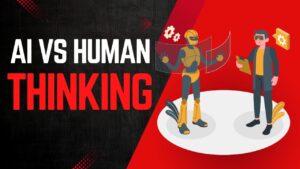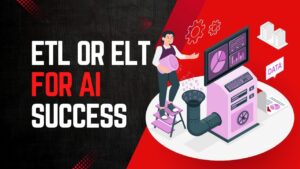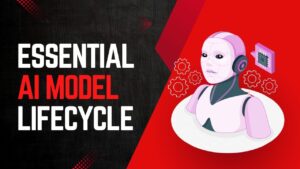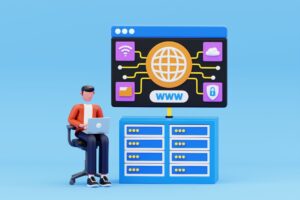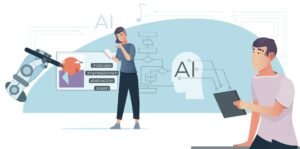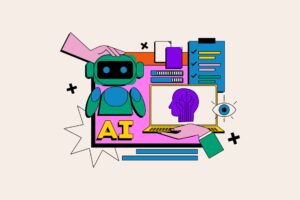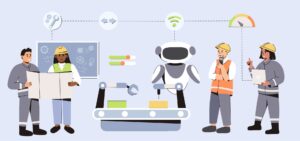In 2025, AI agents are making waves, automating tasks that once required human expertise, from controlling home appliances to navigating complex environments. These agents are intelligent systems that perceive their surroundings through sensors, process information, and act via actuators to achieve goals. Imagine a robotic vacuum cleaner dodging furniture or a self-driving car plotting a route—these are AI agents at work. But not all agents are created equal. They vary in complexity, from basic rule-followers to adaptive learners.
This article dives into the five main types of AI agents—simple reflex, model-based reflex, goal-based, utility-based, and learning agents—explaining how they function, their real-world applications, and their strengths and limitations.
On This Page
Table of Contents
What Are AI Agents?
An AI agent is a system that interacts with its environment to achieve specific objectives. It uses sensors to gather data (like a camera detecting obstacles) and actuators to perform actions (like a motor moving a robot). Agents range from simple devices that follow fixed rules to advanced systems that learn from experience. Their importance lies in their ability to automate tasks, enhance efficiency, and tackle complex challenges across industries like healthcare, transportation, and entertainment.
The Five Types of AI Agents
Let’s explore the five types of AI agents, each building on the previous one’s capabilities. We’ll break down their definitions, mechanics, real-world examples, and limitations, using analogies to make them relatable.
1. Simple Reflex Agents
Definition
Simple reflex agents are the most basic AI agents. They operate using predefined condition-action rules, reacting directly to current percepts (environmental inputs) without considering past experiences or future consequences. Think of them as a knee-jerk reaction—quick and automatic.
How They Work
These agents match the current percept to a set of rules in an “if-then” structure. If a condition is met, the corresponding action is triggered. For example, a thermostat checks the temperature (percept) and turns on the heat (action) if it’s too cold. The process is:
- Sensors detect the environment.
- Rules map percepts to actions.
- Actuators execute the action, affecting the environment.
Real-World Analogy
Imagine touching a hot stove and instantly pulling your hand away. You don’t think about past burns or future risks—you just react. Simple reflex agents work similarly, responding to immediate stimuli without memory or planning.
Examples
- Thermostat: Turns heating on if the temperature drops below 18°C and off when it reaches 22°C .
- Traffic Light System: Changes signals based on timers or sensor inputs, like detecting cars at an intersection.
- Spam Filter: Flags emails as spam if they contain specific keywords, like “win a prize.”
Here’s a Python snippet for a simple reflex vacuum cleaner agent that sucks dirt if the current location is dirty or moves to another location if clean:
def reflex_vacuum_agent(location, status):
if status == 'Dirty':
return 'Suck'
elif location == 'A':
return 'Right'
elif location == 'B':
return 'Left'
# Example usage
print(reflex_vacuum_agent('A', 'Dirty')) # Output: Suck
print(reflex_vacuum_agent('A', 'Clean')) # Output: Right
print(reflex_vacuum_agent('B', 'Clean')) # Output: LeftAdvantages and Limitations
- Advantages: Fast and efficient in predictable, fully observable environments where rules are clear.
- Limitations: Struggles in dynamic or partially observable settings. Without memory, it may repeat mistakes, like a vacuum cleaner stuck in a loop if it can’t track cleaned areas.
2. Model-Based Reflex Agents
Definition
Model-based reflex agents are a step up, maintaining an internal model of the world to track its state over time. This model allows them to handle partially observable environments by remembering past percepts and predicting the effects of their actions.
How They Work
These agents update their internal model based on:
- Percepts from sensors.
- Actions they’ve taken and their outcomes.
- State transitions in the environment.
They use this model to infer the current state and apply condition-action rules, enabling decisions even when direct percepts are incomplete. For instance, a robotic vacuum cleaner remembers which areas it has cleaned.
Real-World Analogy
Think of a person searching for their keys. Instead of checking every spot randomly, they recall where they last left them (the kitchen counter) and go there. The memory of past locations is like the agent’s internal model.
Examples
- Robotic Vacuum Cleaner: Uses sensors (bump, cliff, dirt) and a map to track cleaned areas and avoid obstacles .
- Smart Thermostat: Adjusts heating based on learned user schedules and past temperature patterns.
Code Example
A model-based vacuum agent might maintain a state of locations. Here’s a simplified Python example:
state = {'A': 'Clean', 'B': 'Clean'} # Initial state
def model_based_vacuum_agent(location, status):
global state
state[location] = status # Update state
if status == 'Dirty':
return 'Suck'
elif state['A'] == 'Clean' and state['B'] == 'Clean':
return 'NoOp'
elif location == 'A':
return 'Right'
elif location == 'B':
return 'Left'
# Example usage
print(model_based_vacuum_agent('A', 'Dirty')) # Output: Suck
state['A'] = 'Clean' # After sucking
print(model_based_vacuum_agent('A', 'Clean')) # Output: RightAdvantages and Limitations
- Advantages: Handles partially observable environments by tracking state, making it more robust than simple reflex agents.
- Limitations: Still reactive, not planning for future goals, and requires an accurate model to function effectively.
3. Goal-Based Agents
Definition
Goal-based agents focus on achieving specific goals, using their internal model to plan actions that lead to desired outcomes. They move beyond reactive rules to strategic decision-making.
How They Work
These agents:
- Maintain an internal model of the world.
- Define a goal (desired state).
- Simulate future states for possible actions to find a path to the goal.
They use search or planning algorithms to select actions that advance toward the goal, like a GPS finding the fastest route.
Real-World Analogy
Planning a road trip is a good analogy. You have a destination (the goal) and consider routes, traffic, and stops to get there efficiently. Goal-based agents similarly evaluate options to reach their objective.
Examples
- Self-Driving Cars: Plan routes to a destination, adjusting for traffic and obstacles.
- Chess Programs: Evaluate moves to achieve checkmate or a strong position.
Pseudocode
Here’s a conceptual pseudocode for a goal-based agent:
def goal_based_agent(percept):
state = update_state(percept)
if goal_achieved(state):
return 'NoOp'
else:
plan = find_plan_to_goal(state)
if plan:
return plan[0]
else:
return 'RandomAction'Advantages and Limitations
- Advantages: Adapts to changing environments by planning toward goals, ideal for robotics and navigation.
- Limitations: May not optimize for efficiency or secondary factors, like energy use, focusing only on goal achievement.
4. Utility-Based Agents
Definition
Utility-based agents aim to maximize a utility function, which quantifies the desirability of different outcomes. They choose actions that not only achieve goals but do so optimally, considering factors like cost, time, or safety.
How They Work
These agents:
- Maintain an internal model and goals.
- Assign a utility score to possible future states.
- Select the action with the highest expected utility.
For example, a drone might evaluate routes based on delivery time, battery use, and weather risks.
Real-World Analogy
Choosing a restaurant isn’t just about proximity (the goal). You consider food quality, price, and ambiance to pick the best option. Utility-based agents make similar trade-offs to maximize satisfaction.
Examples
- Autonomous Drone Delivery: Selects routes to minimize time and energy while ensuring safety.
- Investment Portfolio Managers: Balance returns and risks to maximize financial gains.
Pseudocode
Here’s a pseudocode for a utility-based agent:
def utility_based_agent(percept):
state = update_state(percept)
actions = possible_actions(state)
best_action = max(actions, key=lambda a: expected_utility(state, a))
return best_actionAdvantages and Limitations
- Advantages: Optimizes outcomes by considering multiple factors, suitable for complex decision-making.
- Limitations: Requires an accurate utility function, which can be hard to define, and may be computationally intensive.
5. Learning Agents
Definition
Learning agents are the most advanced, capable of improving their performance by learning from experience. They adapt to new situations, making them ideal for dynamic environments.
How They Work
Learning agents have four components:
- Performance Element: Selects actions based on current knowledge.
- Critic: Evaluates outcomes against a performance standard, providing feedback (e.g., rewards in reinforcement learning).
- Learning Element: Updates knowledge based on feedback.
- Problem Generator: Suggests new actions to explore.
They learn by trial and error, refining their strategies over time, like an AI chessbot improving through games.
Real-World Analogy
A child learning to ride a bike falls, adjusts, and tries again, eventually mastering it. Learning agents similarly improve through experience, adapting to feedback.
Examples
- AI Chessbots: Refine strategies by analyzing thousands of games (Botpress AI Agents).
- Recommendation Systems: Learn user preferences, like Netflix suggesting shows based on viewing history.
- Fraud Detection: Adapt to new scam patterns in financial systems.
Advantages and Limitations
- Advantages: Highly adaptable, capable of handling complex, changing environments.
- Limitations: Requires significant data and time to learn, and may make errors during the learning phase.
Multi-Agent Systems
Multi-agent systems involve multiple agents operating in a shared environment, either cooperating or competing. For example:
- Swarm Robotics: Robots collaborate to perform tasks like search and rescue.
- Economic Simulations: Agents model market behaviors, competing for resources.
These systems leverage collective intelligence but require coordination to avoid conflicts or inefficiencies.
The Role of Human Oversight
While AI agents are powerful, they often perform best with human-in-the-loop oversight, especially for critical tasks. Humans provide context, ethical judgment, and error correction, ensuring agents align with real-world needs and safety standards.
Comparison of AI Agent Types
| Agent Type | Maintains State | Uses Goals | Uses Utility | Learns |
|---|---|---|---|---|
| Simple Reflex | No | No | No | No |
| Model-Based Reflex | Yes | No | No | No |
| Goal-Based | Yes | Yes | No | No |
| Utility-Based | Yes | Yes | Yes | No |
| Learning | Yes | Yes | Yes | Yes |
WrapUP
AI agents are transforming how we interact with technology, from simple thermostats to adaptive chessbots. Each type—simple reflex, model-based reflex, goal-based, utility-based, and learning agents—offers unique strengths, suited to different tasks and environments. By understanding their capabilities and limitations, we can better harness their potential while recognizing the value of human oversight in complex scenarios. As AI continues to evolve, these agents will play an increasingly vital role in our lives, making tasks smarter, faster, and more efficient.

FAQs
What is an AI agent?
An AI agent is a system that perceives its environment through sensors, processes information, and takes actions via actuators to achieve specific goals. Think of it as a digital assistant, like a thermostat adjusting room temperature or a self-driving car navigating roads. AI agents vary in complexity, from simple rule-followers to adaptive learners, and are used in applications like robotics, recommendation systems, and automation.
What are the five main types of AI agents?
The five main types of AI agents, based on their decision-making and intelligence, are:
Simple Reflex Agents: React to current inputs using predefined rules, like a thermostat.
Model-Based Reflex Agents: Maintain an internal model of the world to track state, like a robotic vacuum cleaner.
Goal-Based Agents: Plan actions to achieve specific objectives, like a self-driving car.
Utility-Based Agents: Optimize outcomes by evaluating preferences, like a drone choosing efficient delivery routes.
Learning Agents: Improve performance over time through experience, like an AI chessbot.
How does a simple reflex agent work?
A simple reflex agent operates using condition-action rules that link current percepts (environmental inputs) to actions. It’s like a reflex: if a condition is met, it triggers an action without considering past or future states. For example, a thermostat turns on heating if the temperature drops below 18°C. It uses:
Sensors to detect the environment.
Rules (e.g., “if temperature < 18°C, then heat”) to decide.
Actuators to act. It’s fast but limited to predictable settings, as it lacks memory.
What is the difference between a simple reflex agent and a model-based reflex agent?
The key difference is that a simple reflex agent reacts only to current percepts using fixed rules, while a model-based reflex agent maintains an internal model of the world to track its state over time. For instance:
A simple reflex vacuum cleaner sucks dirt if it detects it but doesn’t remember cleaned areas.
A model-based vacuum cleaner tracks which areas are clean, avoiding redundant cleaning. The model-based agent handles partially observable environments better but is still reactive, not planning for goals.
Can you explain how goal-based agents function with an example?
Goal-based agents focus on achieving a specific goal by using an internal model to simulate future outcomes and plan actions. They evaluate which actions move them closer to the goal, unlike reflex agents that only react. For example, a self-driving car with the goal of reaching a destination:
Uses its model (current location, map) to predict outcomes (e.g., “turning left leads to the highway”).
Selects actions (e.g., “turn left”) that advance toward the goal. This planning makes them ideal for navigation and robotics.
What is the purpose of the utility function in utility-based agents?
The utility function in utility-based agents quantifies the desirability of different outcomes, allowing the agent to choose the best action, not just any that meets a goal. It assigns a “happiness score” to possible future states, considering factors like cost, time, or safety. For example, an autonomous drone delivering a package uses a utility function to evaluate routes based on speed, battery use, and weather, selecting the one with the highest utility (e.g., fastest and safest).
How do learning agents improve their performance over time?
Learning agents improve by learning from experience, using four components:
Performance Element: Selects actions based on current knowledge.
Critic: Evaluates outcomes against a standard, providing feedback (e.g., a reward in reinforcement learning).
Learning Element: Updates knowledge based on feedback, refining strategies.
Problem Generator: Suggests new actions to explore. For example, an AI chessbot plays games, loses, adjusts its strategy via feedback, and tries new moves, becoming better over thousands of games.
What are some real-world applications of each type of AI agent?
Each type of AI agent has specific applications:
Simple Reflex: Thermostats (adjust temperature), traffic lights (change based on timers), spam filters (flag emails with keywords).
Model-Based Reflex: Robotic vacuum cleaners (track cleaned areas), smart thermostats (learn user schedules).
Goal-Based: Self-driving cars (navigate to destinations), chess programs (aim for checkmate).
Utility-Based: Autonomous drone deliveries (optimize routes), investment managers (balance returns and risks).
Learning: AI chessbots (improve strategies), recommendation systems (e.g., Netflix), fraud detection (adapt to new patterns).
What are multi-agent systems and how do they operate?
Multi-agent systems involve multiple AI agents operating in a shared environment, either cooperating or competing to achieve goals. For example:
Cooperative: Swarm robotics, where robots collaborate for tasks like search and rescue.
Competitive: Economic simulations, where agents model market behaviors. They require coordination to avoid conflicts, using communication or shared protocols, and leverage collective intelligence for complex tasks, like optimizing traffic flow in smart cities.
What are the expected future developments in AI agent technology?
As of May 2025, future developments in AI agent technology may include:
Enhanced Learning Agents: Integration with advanced generative AI and large language models for better adaptability and natural language processing.
Increased Autonomy: More autonomous agents in robotics and automation, reducing human intervention, though ethical and safety concerns persist.
Multi-Agent Collaboration: Growth in multi-agent systems for applications like smart grids or autonomous logistics, requiring robust coordination.
Human-AI Collaboration: Improved human-in-the-loop systems to balance autonomy with oversight, especially in critical areas like healthcare and defense. These trends reflect ongoing research into more intelligent, ethical, and efficient agents.


